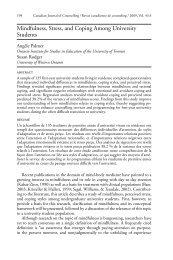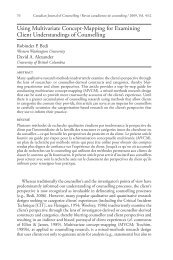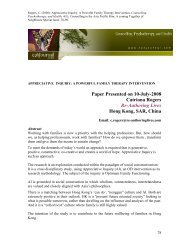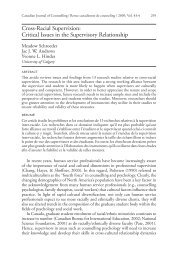PROFESSIONAL COUNSELLOR - Mental Health Academy
PROFESSIONAL COUNSELLOR - Mental Health Academy
PROFESSIONAL COUNSELLOR - Mental Health Academy
- No tags were found...
Create successful ePaper yourself
Turn your PDF publications into a flip-book with our unique Google optimized e-Paper software.
THE <strong>PROFESSIONAL</strong> <strong>COUNSELLOR</strong>03 2007behaviour - they could use either planned ignoring ortime out.C then highlighted what each was and explainedthat if they use planned ignoring they must NEVERgive into the child and that the screaming willprobably increase for a short time before decreasing.On the other hand if they use time-out then they mustalways put the child in time-out whenever she screamsand again must never give in.Steve and Jan decided that they would try plannedignoring first. C then gave them the following step bystep guide on how to ignore Kim’s screaming.• Step 1. Look away from your child or turn yourback on the child within 5 seconds.• Step 2. Move away from your child (at least 3feet). Leave the room if you can.• Step 3. Maintain a neutral expression on yourface. No smiling or looking upset. Keep in mindthat if your child detects that they are getting toyou then they have your attention and thechances of the screaming worsening is increased.• Step 4. Ignore everything your child says. Do notenter into any conversations with them. You cantell them at the outset that you are going toignore their screaming.• Step 5. Begin ignoring as soon as your childengages in the unwanted behaviour. The sooneryou can cut of the supply of attention thatmaintains the unwanted behaviour, the better theresults.C advised Steve and Jan to back up the plannedignoring of the screaming with labelled praise of Kim’sbehaviours which they like. This can be used to tell achild exactly what it is a parent likes about the child’sbehaviour e.g., “Kim, I really liked the way you werequiet when I was on the phone” or “Kim, I really likethe way you are playing quietly”. The idea of this isthat Kim will prefer to behave in ways which receiveparental attention or rewards.When Steve and Jan implemented the program theyfound that for 2 weeks Kim’s screaming did increasebut they continued to ignore it and in the third weekthe behaviour started to decrease.A final session was set“If they usetime-out thenthey mustalways put thechild in timeoutwhenevershe screamsand again mustnever give in.”for 4 weeks after Steveand Jan began to changeKim’s behaviour. Thefinal session wasdesigned to iron out anyproblems which mayhave occurred. Acommon problem whenintroducing a behaviourmodification program isthat other problembehaviours may surface.In the final session Calso explained to Steveand Jan that the programthey implemented was designed to decrease anundesirable behaviour but programs can also beintroduced to increase a child’s desirable behaviour.Examples of behaviours a parent may want toincrease could be time spent on homework or a childpicking up all their toys. Programs designed toincrease a child’s desirable behaviour use rewards andreinforcers including star charts. This visual aspect tobehaviour change can help increase a child’s selfesteem as they are given responsibility to choosewhich way they want to behave. If they choose theappropriate way then they receive a reward.9
















